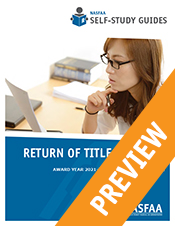NASFAA Self-Study Guides
 NASFAA Self-Study Guides are the answer to your training needs. Written for the independent learner, each Self-Study Guide includes multiple lessons with a variety of exercises to reinforce each lesson. You'll study independently and take quizzes in a traditional paper format (not online). Then you can qualify to take the related credential test and potentially earn a NASFAA Professional Credential.
NASFAA Self-Study Guides are the answer to your training needs. Written for the independent learner, each Self-Study Guide includes multiple lessons with a variety of exercises to reinforce each lesson. You'll study independently and take quizzes in a traditional paper format (not online). Then you can qualify to take the related credential test and potentially earn a NASFAA Professional Credential.
Self-Study Guides include:
- Learning objectives
- Key concepts
- Quick quizzes
- Reflection questions
- Learning activities
Any Self-Study Guide purchase made by someone at your institution is available for download by any roster member. Items that are available without purchase will display "Access" and link to a location to download from this and the purchase page. Learn more about our Self-Study Guides on our FAQs page.
In addition to accessing your Self-Study Guide as a PDF, NASFAA members can view your guide in an interactive e-Reader format, through the RedShelf platform. The e-Reader format offers members the ability to highlight, take notes, and create flashcards right in your Self-Study Guide. To get started, visit our FAQs page.
For individuals new to the financial aid profession, NASFAA suggests moving through the credentials in the order shown.
NASFAA’s Self-Study Guides and supporting materials are updated each spring, and published materials may not immediately reflect changes made as a result of updated guidance from the U.S. Department of Education (ED). As always, financial aid administrators should monitor guidance published by ED throughout the year to be aware of any and all changes.



